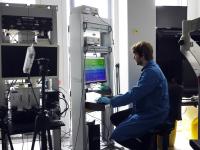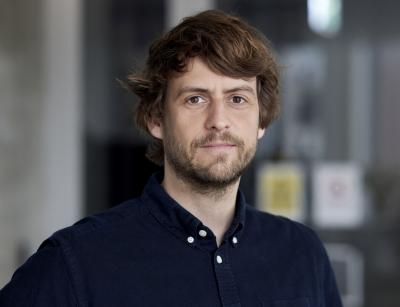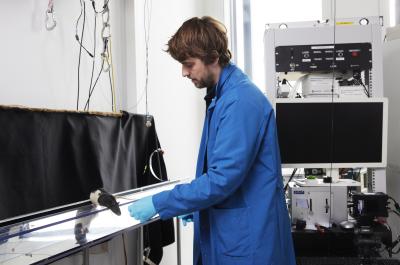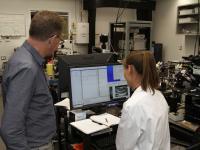He asked a Brain Prize winner: Would you let me do research in your lab?
The outcome of this question is that, today, Peter Petersen, a 37-year-old Danish neuroscientist, is working in the laboratory of world-renowned Professor György Buzsáki at New York University. And funding from the Danish Council for Independent Research and a Lundbeck Foundation postdoc scholarship made it all happen.

Peter Petersen studerer thetarytmer, der er en del af hjernens elektriske aktivitet. Disse rytmer er blandt andet involveret i indlæring og hukommelse.
Who on earth would think of fitting a tiny “fridge” onto the head of a lab rat and then letting it run around in a maze?
The answer is: Peter Petersen, a Danish electrophysiologist and neuroscientist, specialising in theta oscillations – a phenomenon of the brain’s electrical activity.
And his “fridge” – in reality, a small container filled with dry ice – serves a clear scientific purpose:
‘Basically, we’re trying to improve our understanding of theta oscillations, which are involved in human learning, memory, and spatial navigation,’ Petersen explains.
‘When it comes to theta oscillations, we still have much to explore and document. For example, where in the brain do they occur? How are they generated? And to which centres in the brain are they transmitted? This is the field I work in, and this is where the trials with rats with the tiny “fridges” on their heads come into the picture.’

Peter Petersen, 37, is a fine example of the inspirational power of high-quality science. The fact that, today, he is part of the scientific team at world-famous neuroscientist Professor György Buzsáki’s laboratory at New York University is, to a certain extent, thanks to a prize: The Brain Prize. It is the world’s largest brain research prize, has been awarded by the Lundbeck Foundation every year since 2011 and is worth DKK 10 million (around EUR 1.3 million).
György Buzsáki was one of the recipients in 2011, honouring his many years of work to map the underlying structure – the syntax – of the immensely complex communication network connecting the various centres of the brain.
After receiving The Brain Prize, Buzsáki held a range of lectures in Danish neuroscience research environments. Peter Petersen attended one of these, and he remembers being completely enthralled:
‘It inspired me to write to Buzsáki, who at the time was affiliated with a different American university – Rutgers. I asked him whether I could come to the States to study and work for a while in his lab. Buzsáki answered that it could be arranged, and I visited his lab for the first time in 2013. By then, the laboratory had moved to New York University. I had a six-month visa, and the secondment was part of my PhD thesis.’
After the six months were over, Petersen returned to Denmark and completed his PhD under the supervision of Associate Professor Rune Berg at the Department of Neuroscience, University of Copenhagen. Petersen says that, once his thesis was finished, he ‘could again feel the pull of Buzsáki’s lab’:
‘I wrote to Buzsáki and asked whether I could come over to him and write my postdoctoral thesis. He said, “Yes, if you can bring your own research funding with you”. So, I started applying for funding. I received a grant for two years from the Danish Council for Independent Research and another for a further two years from the Lundbeck Foundation in the form of a postdoc scholarship. Once the two years were up, Buzsáki employed me.’
Does cold work?
If you are a researcher and want to tackle a really complex issue, you could, for instance, choose to study the “syntax” of the brain – the underlying structure enabling communication between the various centres of the brain that control a wide range of vital functions. Not until we begin to decipher this structure will we start to see and understand in more detail how the brain actually works.
It is like learning a new language, which is also how Professor Buzsáki tends to explain it. You can get by if you know 100 words of the language. However, if you really want to understand a language, you need to be familiar with the grammar and syntactic rules that enable you to combine words to create complex, meaningful sentences.

But how do you study the brain’s syntax?
A classic method for studying features of the brain is to look for correlations between various stimuli from the surroundings and reactions in the brain.
In many respects, this method works fine, but it does not provide a deeper understanding of the brain’s syntax – this is where we need to think out of the box. And this is the premise for the theta oscillation studies Peter Petersen has been conducting for some years now at the Buzsáki lab at New York University.
Petersen’s hypothesis suggests that theta oscillations are generated in a centre of the brain called the medial septum.
The assumption is that oscillations from this centre, which is presumed to play a role akin to that of conductor of an orchestra, are spread to numerous other centres in the brain, including the hippocampus – which has implications for short-term memory, problem-solving and assimilating new impressions.
‘The big question was how to test this hypothesis,’ Petersen explains.
It turned out that the answer was “by cooling”. The inspiration to take this direction originated from a study conducted by other researchers, using songbirds.
This particular research group had discovered that it is possible to get songbirds to sing slower – to slow down their rhythm – by cooling a certain region of their brain.
Peter Petersen decided to study theta oscillations using an adapted version of this cooling technique. However, he chose to use rats for the trials because rats have been used in studies of the hippocampus for many years.
When they began the study in the Buzsáki lab, a small container with dry ice was attached to the head of each rat, and a silver wire ran from the container into the animal’s medial septum. And it got results:
Peter Petersen and György Buzsáki, who performed the test together, were able to record a slowdown in theta oscillations compared with the usual theta frequency in a rat’s hippocampus.
They were also able to ascertain that – in some way or other – the theta oscillations in the hippocampus were closely linked to the change in activity in the medial septum.
‘The cold-conducting silver wire that we inserted into the medial septum – so, into the region of the rats’ brains that acts like an orchestra conductor – slowed down the theta oscillations in the hippocampus. The oscillations were still there but the frequency decreased. A little like playing a 45 record at 33 rpm,’ says Petersen.
For ethical reasons, trials with the tiny “fridge” can hardly be conducted with human subjects. Nonetheless, the findings of the rat study are interesting for many reasons, and they help us gain a better understanding of the function of theta oscillations in humans.
‘Due to the way theta oscillations operate in the hippocampus, for instance, we know that they play a crucial role in maintaining important cognitive functions such as memory and our ability to learn. The rat trials indicate that it may be relevant to study potential correlations between changes in theta oscillations and cognitive impairment.’
